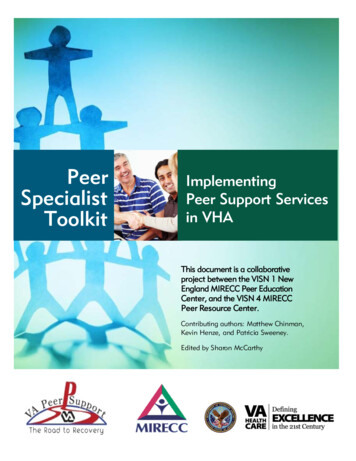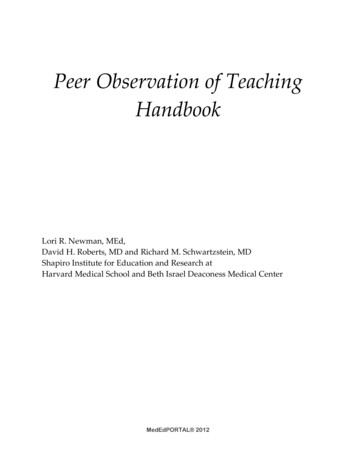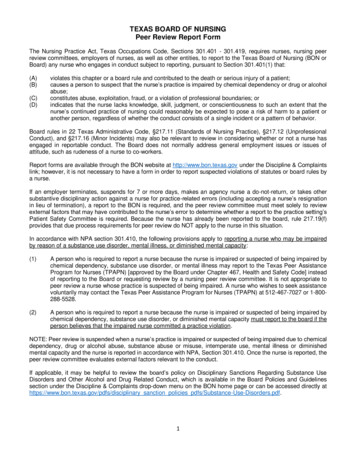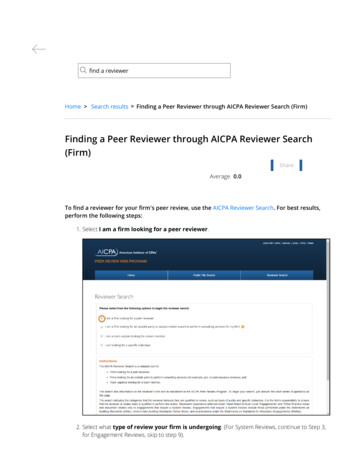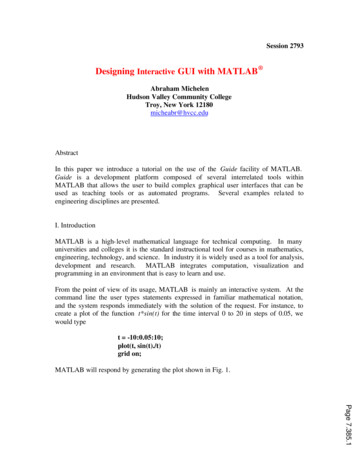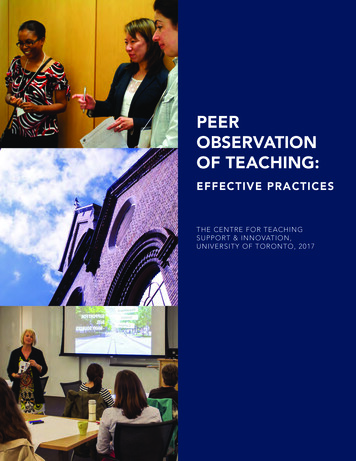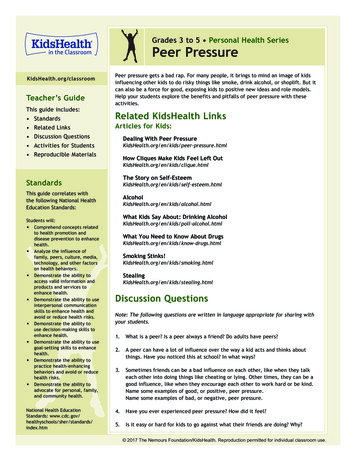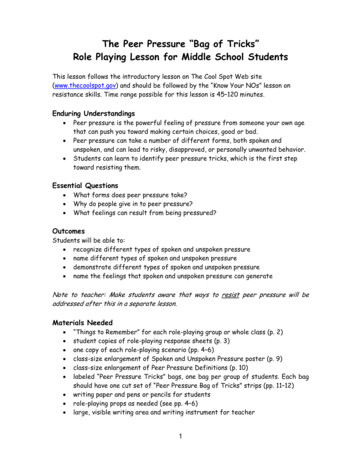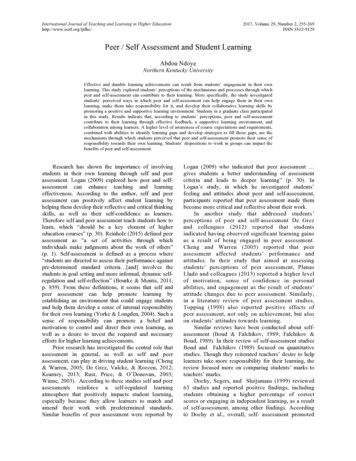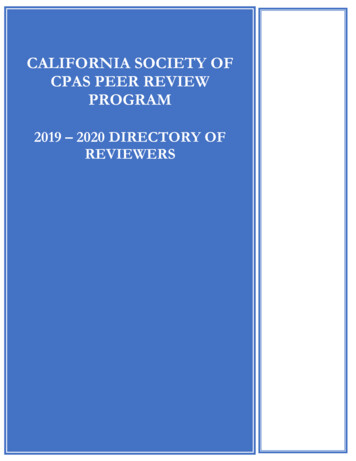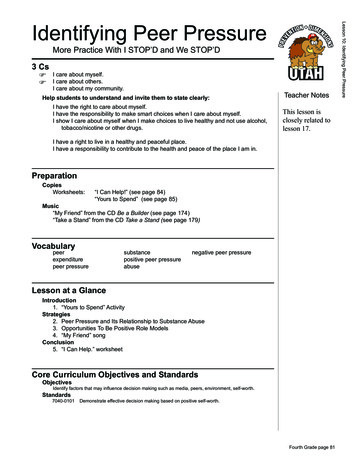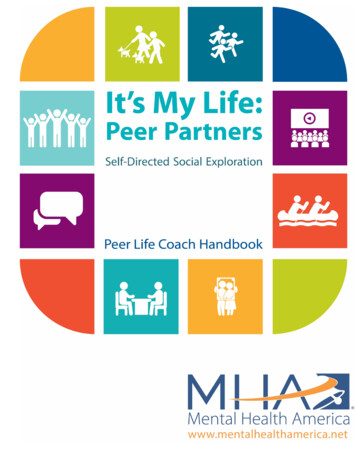
Transcription
It’s My Life: Peer Partners(Self-Directed Social Explorations)Peer Life Coach HandbookPatrick Hendry, Program DirectorThis document is dedicated to the memory ofShavonne G. Carpenter, CPRS, Head Life Coach/TrainerMental Health America 20171
Table of ContentsIntroduction . 5Mental Health America . 5Program Purpose . 6Program Overview . 7Benefits of the Peer Partner Group Model . 9Using the Peer Life Coach Handbook .10Program Operation .12Roles in IML .12Program Director .12Peer Life Coach .14Participant .15Participant Handbook .16Peer Partners.16End of Program Preparation .17Peer Life Coach Guidelines .18Getting Acquainted .18Boundaries .19Self-Care .19Support Group Facilitating .22Facilitator Functions .22Required Skillsets .25Conducting Meetings .332
Group Guidelines .36Additional Recommendations .38Lesson Plans .40Goal SettingMy Social Starting Point.41Setting Social Goals .43Making Social Strides .45CommunicationAssertive Communication .50Shared Decision Making.51Communication Comfort .54Role Playing.55Coping StrategiesEmotion Regulation .57Deep Breathing .59Grounding Techniques .60Mindfulness .62Thoughts and BeliefsAffirmations .64Challenging My Thoughts .66De-catastrophizing .67Focusing and Attending .683
Social InteractionSocial Skills Comfort .69Friendship .70Conversation Etiquette .72Dining Etiquette.74Self-CareSelf Esteem – Self Concept .77Sleep Hygiene.78Importance of Support .80Self-Awareness and Discovery .82Conclusion.86References.874
IntroductionMental Health America (MHA)Mental Health America is the nation’s oldest advocacy organization addressingthe full spectrum of mental health and substance use conditions and theprofound impact they have on public health and our society. MHA wasestablished by former psychiatric patient Clifford W. Beers. During his stays inpublic and private institutions, Beers witnessed and was subjected to horribleabuse. From these experiences, Beers set into motion a reform movement thattook shape as Mental Health America. In all our work, we focus on: preventionfor all; early identification and intervention for those at risk; integrated healthand behavioral health care for those who need it; and recovery as a goal.Formed in 1909, MHA has an established record of effective national andgrassroots advocacy and achievement. With our 200 affiliates across thecountry, we are a potent voice for healthy communities throughout the nation.The National Headquarters for MHA successfully launched the It’s My Life Social Explorations Program in the Northern Virginia area.5
IntroductionProgram PurposeThe purpose of the It’s My Life Program is to improve the lives of people livingwith Serious Mental Health Conditions (SMHC). It is a highly innovativeintervention that combines the two evidence-based practices of Peer Support andPsychiatric Rehabilitation and the emerging best practice Self-Directed Care intoan integrated skill and support strategy that is specifically constructed to helppeople with SMHC build networks of friends and intimate relationships. Successin this area is a major breakthrough for some of the most isolated, misunderstoodmembers of communities. As an essential aspect of recovery, people with SMHCneed to be included in their communities as more than just residents. Socialexclusion, isolation, and poverty exacerbate disability and are associated with illhealth and premature death (Wilkinson, R., Marmot, M., 2003). When peopleare excluded from the day to day activities of their community, whether by theeffects of illness or by societal discrimination, they either lose or never learn theskills necessary to successfully navigate socially or to seek out, initiate, and formnew bonds and friendships.The original pilot program was conducted with people living with schizophreniaor schizoaffective disorder. It is well documented that individuals with thesedisorders have the most difficulty making friends and participating in the sociallife of their communities. The It’s My Life Program is designed to help buildsocial networks of friends and close relationships, thus creating a strong socialsupport system. This in turn helps the participants to become active members ofthe community and feel less isolated which also helps to increase self-esteem andself-worth to improve overall social functioning. This contributes to an increaseof overall physical health which has been shown to decrease the need forhospitalization as well as aiding in avoiding premature death. Studies haveshown that those who live with serious mental health conditions die 10 to 256
years earlier than the general population. Ultimately, the program helps theparticipants to set and reach social and personal goals that may include goingback to school, finding a volunteer position, or even gainful employment.Another essential element to the It’s My Life Social Explorations Program is thatit is kept non-clinical. All clinical language was taken out except for diagnosisand hospitalization history. The use of everyday language fosters increased trustwith the participants. It was made very clear from the start that the Program wasabout Peer Support and not the traditional doctor/patient relationship. This putsthe participants at ease.Program OverviewThe It’s My Life Program advances recovery and improves the lives of individualswith psychiatric conditions with a focus on some of the most isolated,misunderstood members of our communities. Participants are accompanied ontheir recovery journeys by trained Peer Life Coaches who help them bridge thegap to a larger social world. The Program and staff provide a safe place forindividuals to learn and practice skills to prepare themselves as they moveforward on their chosen recovery path. The Life Coaches assist peers in findingtheir power to reclaim their place in the community.While many programs attempt to provide people with social skills training, mosthave very limited success in really connecting people to friends and community.The It’s My Life Program is designed to fill that gap that exists in current systemsor “treatment as usual”. The Program provides direct skill support andemphasizes that self-direction is not just for those who are “doing well”. Theancillary model of the It’s My Life Program, Peer Partners, applies the sameconcepts using a support group format in place of the one-on-one approach.This results in a significant decrease in expenses for operating the Program.7
It’s My Life uniquely provides each participant opportunities to practice newlylearned skills in a safe and non-judgmental environment with feedback fromtheir Peer Life Coach. Recipients of services are given the chance to determine theskills they feel are important to them as well as financial support to participate inactivities they would not otherwise be able to afford. The process fosters creativeways to increase self-esteem and self-worth improving overall functioning withnetworks that include supportive and sustainable relationships that will increasetheir quality of life. Participants receive a monthly allowance of 60.00 to bespent on advancing toward three (3) social goals that are set with the assistanceof the Peer Life Coach. The amount is pending completion of weekly guidedjournaling and consistently providing proof of purchase (receipts) for how themoney was spent. All expenditures must correlate to the social goals, action planand spending plan.The Peer Life Coach meets with the group of participants weekly. Initial meetingsinclude working on goal setting, skill building and budget planning. Eachparticipant will partner with another and go together into the community onoutings of mutual interest so they can practice their skills and receive feedbackfrom one another as well as support from their Coach. The Peer Life Coaches area safe sounding board for participants to express themselves and work throughchallenges. Coaches also model. When coaches model the qualities that formfriendships and how friends interact through conversation and activities, theparticipants learn not only how to be a friend, but also to recognize whensomeone is a true friend. They learn that friends are honest, understanding,supportive, and loyal. They learn that having friends is both a gift and aresponsibility. When many people talk about their recovery they often say thatthe most important single thing is to have a least one person who believes inthem, one friend. As participants begin to build new relationships, the Peer LifeCoach slowly and through discussion begins to lead participants to decrease their8
reliance on their peer partner, the group and the coach. The ultimate goal is forpeer partners and Coaches to be supporters who are available when needed, butnot the only persons participants build friendships with. Evaluation techniquesfor assessing the success of the program include Analysis of Participants’ GuidedJournals, anonymous satisfaction surveys, re-hospitalization rates and trends ofthe Personal Outcome Measures survey results.Benefits of the Peer Partner Group ModelThere are several advantages to utilizing the Peer Partner support group modelof the It’s My Life (IML) Program. Among the most impactful is the automaticexponential increase in the provision of peer support. Unlike the original modelwhere the primary (and sometimes sole) source of peer support is the Peer LifeCoach, participants in IML Peer Partner will be connected to and supported byother program participants. During the piloting of IML, Mental Health Americahosted three gatherings for all the participants to get together to share theirexperiences, interests and ideas. There, three of the ladies discovered they had acommon interest in going to the circus. With the assistance of the Life Coach,they coordinated the outing. After the events, several participants expressedappreciation about having the safe place to practice socializing with people theydidn’t know. Participants in IML Peer Partner will have that opportunity everyweek. Additionally, they can share their knowledge of available resources andsocial opportunities.The shared experience of social challenges promotes a strong sense ofcompassion. Meanwhile, observing others as they face those challenges tends tonormalize the experience. Participants will be giving and receiving feedbackfrom each other. Oftentimes, this generates discussions where participants willhighlight the successes of their peers, but overlook their own progress. As theawareness of this practice increases, participants will learn to recognize and9
celebrate all of their victories. Generally, the group naturally and gently providesaccountability and encouragement in this area.There are also positive financial implications to using the support group model.The costs of operating the program are greatly reduced by allowing the Peer LifeCoach to work with multiple people at the same time. The time and expenses offunding the Coach’s travel and participation in outings are nearly eliminated.The monetary benefit also potentially extends to participants as they are able toshare the costs of transportation with their Peer Partner, or even receive groupdiscounts if several members attend the same event.How to Use the Peer Life Coach HandbookThe principles and practices enumerated in the It’s My Life – Social Self-DirectedCare Program Operation Manual are essential to successfully achieving thedesired outcomes. The Peer Life Coach Handbook is to be used in conjunctionwith the Program Operation Manual. Its focus is on adapting the program to agroup format rather than one-on-one services. The lesson plans, structure andskillsets detailed may also be helpful for Peer Life Coaches in a one-on-onesetting.It’s My Life is designed to be a year-long program. It should be noted that thelength of enrollment for each participant may vary based upon individual needsand other factors. The Peer Life Coach meets with the group of participantsweekly. The group needs to have an even number of participants so each personwill have a peer to partner with, a “Peer Partner”. Having at least six, but nomore than twelve is the recommended group size. Each month the meetings willfocus on a different theme. Life Coaches will select lesson plans for each meetingthat focus on the specified theme based upon the following chart and tailored tomeet the needs of the group.10
Month1st2nd3rd4th5th6th7th8th9th10th11th12thFocal ThemeIntroduction & Goal SettingSelf-CareSocial InteractionCommunicationCoping StrategiesThoughts & BeliefsSocial InteractionSelf-CareCoping StrategiesSocial InteractionCommunicationCoping Skills & Goal Setting (Transitioning Out)Each 90-minute meeting consists of the lesson on a skillset in the focal categoryfollowed by a group discussion on experiences with that skill. Participants willhave opportunities to give and receive feedback from the Life Coach and otherpeers. During each meeting, it is essential that the Peer Life Coach is attentive andin tune with the needs of the group and individual group members. Betweenmeetings, participants are tasked with trying out the skills they have learnedabout. They partner with a fellow participant who has similar social goals andinterests to venture into the community and engage in activities in a variety ofsocial settings. Participants are to journal about their experiences and share themduring the support group portion of the meetings. By listening for overarchingthemes and common threads, the Coach will be able to select the lesson eachweek that will most benefit the group.11
Program OperationBefore initiating implementation of the It’s My Life Program, the providerorganization needs to be able to ensure fidelity to all of the basic principles of theIML model, especially remaining truly self-directed. This is achieved throughproper training of the Peer Life Coach(es) and Program Director. Mental HealthAmerica’s National Office offers personal training and technical support fororganizations implementing this program. It is also helpful for an organization’sleadership and supporting staff to be educated about the program.Program RolesThere are essentially three major roles in the It’s My Life Program. Oversight ofits operation is provided by the Program Director. This includes providingsupervision and support for the Life Coach team as well as approving theMonthly Social Spending Plans for each participant. The Peer Life Coach guidesparticipants through the program with the support of other Program Staff. TheParticipant plays an active role in their recovery as they journey with their peersthrough the process. In-depth explanations and guidelines for these roles isprovided in the IML Program Operation Manual.Program DirectorSupervision is critical in this program in that not only does a professional need tooversee the program but also in the sense that supervising Peer Specialists isdifferent than other behavioral health positions. It is critical that the ProgramDirector understand recovery and the unique skills and assets provided by peerworkers. Supervision includes issues of job role clarification, performance,confidentiality, disclosure, working with other staff, boundaries and others asthey arise. Supervision is also important because it provides an avenue to monitorfor and address instances of vicarious trauma, compassion fatigue or burnout. It12
must be comprehensive, regularly scheduled, and meaningful to the person beingsupervised.In addition to providing supervision, the Program Director also serves as aresource and support system for the Life Coaches. Having appropriate supportavailable is essential in peer support because Life Coaches are working their ownrecovery with day-to-day and job issues while still providing support toparticipants. It has been demonstrated that the most effective ways to reduce therisk of negative impact on the Life Coach’s own recovery are to implementchanges at systemic and organizational levels by balancing workloads, givingstaff more control over their schedules, establishing supportive teams, limitingexposure to trauma and providing additional training. Additionally, Life Coachesmay also benefit from regular debriefing, especially after experiencing a criticalor traumatic event. Support groups provide increased potential for work-relatedstress as Coaches are working with multiple people simultaneously. Thus, it isimportant that Peer Life Coaches are well trained in understanding groupdynamics and managing conflict. As Director, it is vital to be supportive whenLife Coaches are experiencing difficulties with a particular participant or viceversa. The Program Director also responds to all “About My Program”(Grievance) Forms available to participants in their Handbook. The Directorshould also be available to assist if participants call or email expressing concernsabout their Life Coach or the It’s My Life Program. Overall, it is the responsibilityof the organization operating the program to provide the much-needed supportto each of their Life Coaches.The Peer Life Coach will review the goals, plans and budget tracking with eachparticipant monthly. The Program Director has the responsibility of finaloversight of each Participant’s spending. This includes verifying the social goalschosen by the Participant, assuring that the action/spending plans relate directly13
to the accepted social goals and that spending is recorded appropriately on the“Tracking My Budget” Sheet found in the Participant Handbook with properdocumentation (receipts) attached. Coaches and the Program Director will conferas needed.Peer Life CoachDirect services are provided by the Peer Life Coach. Trained in Peer Support,Psychiatric Rehabilitation, Self-Directed Care, Life Coaching, MotivationalInterviewing and Shared Decision-Making, the Peer Life Coach facilitates weeklymeetings with the group of participants. During these meetings, the Coachsupports participants as they set and work toward their social goals.The Peer Life Coach teaches a variety of skills and partners with the group ofparticipants to promote successful application of these skills. One of the mostimportant skills the Peer Life Coach teaches is how to set meaningful andachievable goals. Also among the skillsets are emotion regulation,communication, coping techniques, and other skills as determined through thesessions. The Peer Life Coach educates participants about these skills and modelsappropriate social interaction.With oversight from the Program Director, the Life Coach will review theaction/spending plan of each participant. They will check to make sure eachexpenditure clearly relates to at least one of the social goals that have beenpreviously set. The Life Coach also supports participants as needed in trackingtheir spending and collects the “Tracking My Budget” form with associatedreceipts for proof of purchase. The Life Coach also reviews and collects eachparticipant’s guided journaling. Keeping track of their spending and completionof the journals are contingencies for receiving the Social Activities Budget.14
The Life Coach is there to explicate all policies of the program. The requirementsand processes for the Social Activities Budget are communicated to participantsprior to completing enrollment. Participant Rights, including privacy andvoluntary participation, are also made clear from the outset. Peer Life Coachesare to comply with all HIPAA regulations, adhering to the Privacy andConfidentiality practices outlined in the It’s My Life Program Operation Manual.ParticipantThe It’s My Life Program regards self-determination and autonomy as essentialprinciples. These values inform the processes of the program. Participants areencouraged to apply them throughout the program, beginning even beforeenrollment. Interested individuals contact the service provider directly. This helpsmitigate instances of coercion from well-meaning friends, family and othersupporters.Once it is determined that the individual meets the requirements for eligibility,including ability to give informed consent, manage the social activities budget,and complete the journaling, the need for the services is assessed through thePersonal Outcome Measures Survey Tool ome-measures). Participants in IML Peer Partner willalso be required to attend the weekly meetings. Additionally, with support andguidance of their Peer Life Coach, they will partner with another member ofthe group, serving as ally at outings and social events. Each participant willalso be expected to adhere to the confidentiality policy and any otherguidelines set forth for the group meetings. The rights and responsibilities ofIML participants are detailed in the Program Operation Manual.15
Participant HandbookEach participant receives a Participant Handbook. The contents of which willprovide them with everything they need for the duration of their enrollment. Itincludes ten forms/worksheets and the weekly guided journal. The paperworkcan be completed independently or with the aid of the Life Coach. Copies ofcompleted paperwork are retained as part of the Participant’s file and handled inaccordance with Program Privacy and Confidentiality Procedures. The contentsof the Participant Handbook are detailed in the IML Program Operation Manual.Peer PartnersIn the original version of It’s My Life, participants were accompanied on outingsby their Peer Life Coach. The coach served as a source of moral support andencouragement as participants explored their environments and ventured intounfamiliar, and potentially, uncomfortable settings. In the support group model,this role is performed primarily by the Peer Partners.The first weeks of the program focus on goal-setting and introspection. Throughthe lessons and activities, participants will get to know themselves better. As theyshare in meetings, they will also learn about each other. This is importantbecause each participant, with assistance as needed from the Life Coach, willselect a member of the group to partner with who shares similar interests andsocial goals. The Life Coach may need to provide support as the Peer Partnerscoordinate scheduling and transportation for their social outings. Peer Partnerswill also need time to provide feedback to one another and explore options forfuture outings.The may be times when a Peer Partner team is not working well together. TheLife Coach helps mediate to reach a consensus on the best course of action.Changing Peer Partners should be a last resort as it would require the disruption16
of another team. Peer Life Coaches must also be aware and prepared to addressthe potential impact of these issues on group dynamics. The male/femaledynamic should also be taken into consideration to avoid transference andcounter-transference whenever possible.As participants begin to progress and grow in confidence, they are encouraged totry going out on their own (without their Peer Partner). If there are teams wherean individual’s Peer Partner has reached this stage, it may be appropriate in theseinstances to have them pair up with someone else in the same situation. Thepurpose of the program is not to simply push people to go outside their “comfortzone”, but rather to expand their comfort zones.End of Program PreparationParticipation in the It’s My Life Program is completely voluntary. This should bemade clear to participants from the very beginning. Participants can drop out atany time, but are asked to communicate with the Program Director if they arehaving any problems or conflict with the Program or their Coach. Participantsmay also choose to withdraw if they feel they have accomplished all theircurrent social goals or no longer have an interest in pursuing them at the giventime. Under certain circumstances, participants may be involuntarily dismissedfrom the It’s My Life Program. This can occur if the participant consistently failsto meet their agreed upon obligations of attending weekly groups, completing theGuided Journals and proper use of the social activities budget. In the event of aparticipant withdrawing or being discharged prior to completion of the program,they will be asked to complete an Exit Interview as outlined in the IML ProgramOperation Manual.There is also a transition process for participants who complete the full year ofthe program. The twelfth and final month of meetings and lessons focus on17
phasing out. It is not uncommon for individuals to experience anxiety or similarfeelings toward the conclusion of the program. The change in routine, loss ofsupport (including financially) can become major stressors. The Peer Life Coachshould encourage participants to continue advancing their efforts to growsocially and explore the free or low-cost opportunities they have learned aboutthroughout the program. During this period, emphasis is placed on setting goalsfor the future to build upon the progress that has been made and practicingcoping skills to help with the adjustments.Peer Life Coach GuidelinesGetting AcquaintedWhen people are excluded from the day to day activities of their community,whether by the effects of illness or by societal discrimination, they either lose ornever learn the skills necessary to successfully navigate socially or to seek out,initiate, and form new bonds and friendships. It may be difficult initially forparticipants to connect. The strength of the peer relationship is enhancedthrough regular meetings and strategic self-disclosure. This builds trust andcredibility.Sharing personal stories must be timely, focused and selective to the participant’s(and group’s) comfort, situation and needs. Peer Life Coaches will helpparticipants practice appropriate sharing. They will also foster relationshipbuilding within the group through “Icebreakers” and through developingtrust in a support group environment. Finding others with similar interests isa key ingredient of identifying potential friends and acquaintances. It formsthe basis for conversation and continued connection.18
BoundariesPr
desired outcomes. The Peer Life Coach Handbook is to be used in conjunction with the Program Operation Manual. Its focus is on adapting the program to a group format rather than one-on-one services. The lesson plans, structure and skillsets detailed may also be helpful for Pe
